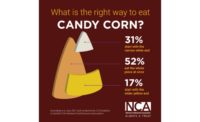Teens want it more, young adults want it less and grandma probably likes her’s dark.
The chocolate market is as sweet as ever, and the National Confectioners Association recently hosted a “Sweet Insights” event about the category to highlight some extremely specific data about the sector.
Larry Wilson, v.p. of consumer relations, provided research and analysis on everything from consumer preferences based on age to online candy sales, obesity information, and seasonal possibilities.
► Adults eat more candy than kids
The most striking information was related to age groups. Contrary to popular belief, it’s actually adults who consume the most candy, Wilson says.
In fact, people 45 and older actually eat more candy than any other age group, according to the NPD Snack Track report. Specifically, those 45-54 ate chocolate 119 times a year, and those between the ages of 55-64 ate chocolate 123 times a year.
That’s higher than the 94 times a year those 35-44 ate chocolate, the 101 times a year those 25-34 ate chocolate, and the 113 times a year those 18-24 ate chocolate.
Also, while children younger than 13 make up 15% of the population, they only eat about 13% of the chocolate.
Research also shows another age-based trend — older groups tend to eat more dark chocolate, according to the NPD Snack Report.
Throughout the year, nearly one-third of all the chocolate they ate was dark, compared to the 15% those 18-44 ate, and the 12% teens 13-17 ate.
Wilson suggested the retailers and manufacturers try harder to explain the health benefits of dark chocolate to younger generations. He also suggested that young adults might be swayed to eat more chocolate if it was suggested they pair it with cheese or wine.
► Online food sales are up, supermarkets still reign supreme.
As for where consumers are buying all their chocolate, The NPD Snack Track report showed that adults are buying about 30% from supermarkets and 27% from discount stores.
Meanwhile, teens were buying 30% from convenience stores and about 19% from supermarkets.
And, customers who are stepping into a brick-and-mortar store are savvier and have higher expectations of the in-store experience.
To illustrate this, Wilson showed a photo of a typical candy aisle featuring laydown bags stacked to be functional and efficient. Then, he showed a candy section featuring lollipops, vibrant colors and whimsical displays.
“You can’t win on price alone, and retailers are starting to understand that,” Wilson says.
He suggested placing chocolate in unexpected areas of the stores, such as the card aisle, to tempt consumers.
Wilson also cited data from Nielsen showing that food and beverage sales are up 44% for online retailers compared to 2010, and candy retailers need to take notice.
“That was a channel that nobody ever thought of for foods, but it’s real, and it’s coming,” he says.
► Candy doesn’t cause obesity
Of course, it’s impossible to to mention chocolate these days without also discussing obesity. And here too, there’s plenty of useful data for retailers.
Most strikingly, candy only accounts for about 6.1% of total added sugar intake, according to research from Euromonitor International in 2011. Also, candy only represents 2-3% of Americans’ caloric intake, according to a report from The Dietary Guidelines for Americans Advisory Committee.
Research also shows obesity rates by country do not correspond with candy consumption. For example, both the British and the Irish eat a lot of candy but have low obesity rates, while Americans eat a relatively small amount of candy but have a high rate of obesity.
“[Obesity] isn’t about confections,” Wilson says.
► Seasonal sales still growing
Of course, it’s not just about the data for consumers. Another way for chocolate companies to fight back against the obesity backlash is to continue to associate candy with a sentimental value.
And perhaps the best way to do that is through seasonal products.
The good news is, seasonal candy sales are very healthy. In fact, about 22% of all the $32 billion in U.S. confectionery sales were seasonal last year, the NCA estimates. Leading the pack is Halloween, with about $2.4 billion in sales, followed by Easter with $2.16 billion in sales, then the winter holidays with $1.5 billion in sales and finally Valentine’s Day, with $1 billion in sales.
The bad news is, consumers wanted to buy even more.
According to the NPD Snack Track Holidays Easter Survey in 2012, 36% of shoppers spent less than they budgeted on holiday candy, and 29% spent less than they budgeted on other holiday snacks and treats.
“We’re leaving money on the table,” Wilson says. “That’s a real opportunity for us.”
One way to combat that is to be solid for the traditional holidays, starting early and selling the holiday up until the day off, before switching to the next season.
Wilson told the story of going to visit retailers the Friday before Halloween a couple years ago and noticing that they had already started displaying Christmas candy, despite the fact that many shoppers wait until the last minute to stock up for trick-or-treaters.
Another potential problem area for seasonal candy in 2013 is shortened holiday seasons. For example, Easter falls on March 31 next year, compared to April 8 in 2012. And, there’s only 26 shopping days between Thanksgiving and Christmas in 2013, compared to 32 in 2012.
“There’s volume risk, and it’s real,” Wilson says.
Some of that could be offset by getting into the more offbeat or under represented holidays and occasions. Everything from Secretaries’ Day to the World Cup as well as a visit from the Tooth Fairy are possible marketing opportunities.
Tet Lunar New Year bar anyone? Or how about a First Car Chocolate?





